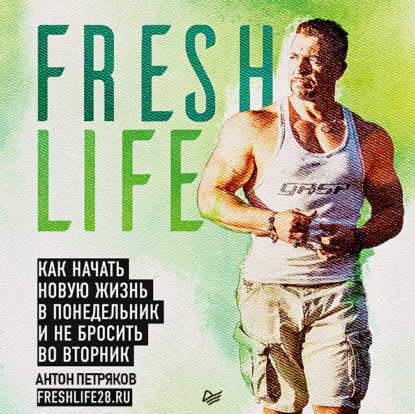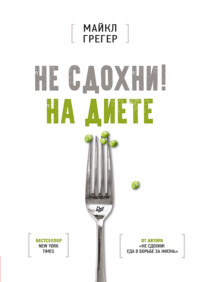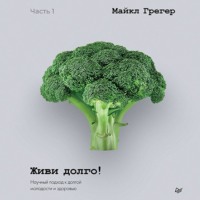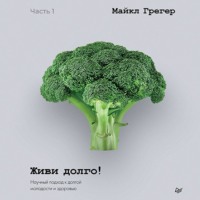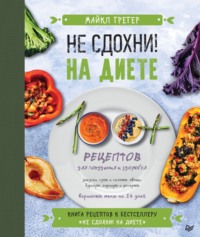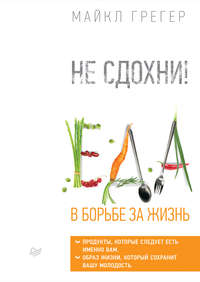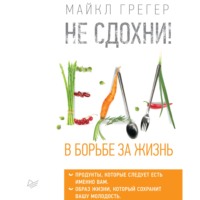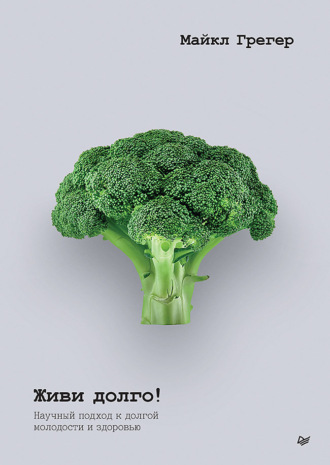
Полная версия
Живи долго! Научный подход к долгой молодости и здоровью
Давно известно, что пищевой холестерин также вносит существенный вклад в развитие атеросклероза[3711]. Проведенный в 2020 году метаанализ более 50 рандомизированных контролируемых исследований показал, что употребление яиц значительно повышает уровень холестерина ЛПНП[3712]. Даже исследования, финансируемые яичной промышленностью, показывают, что яйца повышают уровень холестерина в крови[3713]. Это, по-видимому, приводит к значительному повышению уровня кальция в коронарных артериях у тех, кто ест больше яиц, что является признаком образования атеросклеротических бляшек в артериях[3714], и, что особенно важно, к значительному повышению риска инфаркта и смерти. По данным полудюжины популяционных исследований, проведенных в США, в которых участвовали десятки тысяч людей в течение 30 лет, каждая дополнительная половина яйца в день повышает риск развития сердечно-сосудистых заболеваний и смерти от всех причин, вместе взятых[3715]. Причем этот риск сохранялся даже после корректировки образа жизни, включая качество питания. Другими словами, похоже, что это произошло не только потому, что те, кто ел больше яиц, ели больше и бекона [3716].
Несмотря на давление со стороны яичной индустрии[3717], в диетических рекомендациях для американцев на 2015–2020 годы от Института медицины было прямо указано, что людям следует «потреблять как можно меньше пищевого холестерина»[3718]. Аналогичный совет был повторен в рекомендациях на 2020–2025 годы: «Национальные академии рекомендуют максимально снизить потребление трансжиров и пищевого холестерина»[3719], с тем обоснованием, что любое его потребление, превышающее нулевое значение, увеличивает концентрацию холестерина ЛПНП в крови и, следовательно, повышает риск заболевания, являющегося убийцей номер один[3720].
Как отмечает Дж. Дэвид Спенс, директор Центра профилактики инсульта и изучения атеросклероза, яичная индустрия, будучи уличенной в ложной рекламе за утверждение, что яйца безопасны, «потратила сотни миллионов долларов на то, чтобы убедить общественность, врачей и политиков в безвредности пищевого холестерина». В действительности, как пишет доктор Спенс, регулярного употребления яиц следует избегать людям, подверженным риску сердечно-сосудистых заболеваний, что «по существу означает всех жителей Северной Америки, рассчитывающих дожить до среднего возраста»[3721].
Что насчет липопротеина(a)?
Липопротеин(а), также известный как Lp(a), является фактором риска сердечно-сосудистых заболеваний. Он способствует развитию ишемической болезни сердца, инфарктов, инсультов, заболеваний периферической сосудистой системы, кальциноза аортального клапана и сердечной недостаточности. Эти болезни могут возникать даже у людей без повышенного уровня холестерина[3722], поскольку Lp(a) – это холестерин. По сути, это молекула холестерина ЛПНП, связанная с другим белком[3723], который, как и ЛПНП, переносит холестерин в просвет артерий, способствуя развитию воспаления в атеросклеротических бляшках[3724]. Подробнее о Lp(а) и о том, что мы можем с ним сделать, смотрите на see.nf/lpa и see.nf/lpadiet. Концентрация Lp(а) в крови в основном генетически обусловлена[3725], но есть некоторые изменения в рационе питания, которые могут помочь.
Мы давно знаем, что трансжиры, содержащиеся в мясе и молочных продуктах, так же вредны, как и промышленно произведенные трансжиры, содержащиеся в частично гидрогенизированном масле – распространенном ингредиенте нездоровой пищи, так как способствуют повышению уровня холестерина ЛПНП[3726]. Однако если речь идет о Lp(а), то трансжиры, содержащиеся в мясе и молочных продуктах, оказываются еще хуже[3727]. Однако просто отказаться от мяса и придерживаться оволактовегетарианской диеты[3728], по-видимому, недостаточно[3729]. Есть некоторые растения, которые могут немного помочь, например молотые семена льна[3730] и амла (сушеный порошок индийского крыжовника)[3731]. Когда участники исследования были переведены на цельную растительную диету, до предела насыщенную фруктами и овощами, уровень Lp(а) у них снизился на 16 % за 4 недели. За эти 28 дней они также потеряли в среднем 15 килограммов[3732]. Но потеря веса, как оказалось, не улучшает уровень Lp(а), поэтому исследователи решили, что дело, скорее всего, в питании[3733]. Помимо снижения веса месяц растительного питания может значительно улучшить артериальное давление даже при сокращении приема лекарств от давления[3734]. Кроме того, можно добиться снижения уровня холестерина ЛПНП на 25 пунктов и С-реактивного белка на 30 %, а также значительного снижения других маркеров воспаления, что дает «системный кардиопротекторный эффект»[3735].
Риск инсульта у вегетарианцев
Здоровое питание на основе растительных продуктов ассоциируется с более низкой смертностью от всех причин[3736] – можно говорить о снижении риска смерти от любых причин в среднем на 34 % в течение восьмилетнего периода[3737]. При сохранении этого показателя в зрелом возрасте это означает более четырех дополнительных лет жизни[3738]. Метаанализ десятка исследований, в которых наблюдалось более полумиллиона человек в течение 25 лет, также выявил значительное снижение уровня сердечно-сосудистых заболеваний и общей смертности среди тех, кто питался предпочтительно растительной пищей[3739]. Это неудивительно, говорится в заключении систематического обзора, учитывая данные о том, что программы, основанные на растительном рационе, «потенциально могут стабилизировать или даже обратить вспять развитие ишемической болезни сердца»[3740].
Люди, питающиеся растительной пищей, как правило, стройнее, у них значительно ниже уровень холестерина ЛПНП, триглицеридов, сахара в крови и артериального давления[3741], а также менее выражено утолщение стенок сонных артерий[3742] и образование бляшек[3743], что измеряется с помощью ультразвука в области шеи. Снижение риска может происходить быстро, о чем свидетельствуют результаты одно-[3744] и трехнедельных[3745] программ на основе растительной пищи ad libitum (ешь сколько хочешь). Например, некоммерческая организация Rochester Lifestyle Medicine Institute создала пятнадцатидневную программу для домашнего применения. Из первых нескольких сотен участников, перешедших на цельную растительную диету без контроля порций и подсчета калорий, пациенты с ожирением потеряли в среднем 7 килограммов; у диабетиков уровень сахара в крови снизился на 28 пунктов; у людей с уровнем холестерина ЛПНП более 100 мг/дл – на 33 пункта[3746], что сравнимо с некоторыми статинами[3747]; у гипертоников систолическое давление снизилось на 17 пунктов[3748], что лучше, чем после приема лекарств. Все это было достигнуто всего за 2 недели соблюдения диеты[3749].
Если сравнить работу артерий у тех, кто не ест мяса, и у тех, кто его ест, то здоровая способность артерий нормально расширяться и пропускать больше крови в 4 раза лучше у тех, кто питается как вегетарианец, причем, по-видимому, чем дольше, тем лучше. Степень улучшения работы артерий коррелировала с количеством лет, в течение которых люди не ели мяса. Вместо того чтобы ухудшаться с возрастом, функция артерий становилась тем лучше, чем дольше они питались здоровой пищей[3750].
Исследования, проведенные в течение 35 лет, показывают, что у людей, питающихся растительной пищей, также улучшается «реология» крови, то есть ее текучесть [3751], что может играть защитную роль для сердечно-сосудистой системы[3752]. Последующие интервенционные исследования, в которых были проверены эти результаты исследований, показали, что переход людей на растительную диету может улучшить показатели реологии всего за 3[3753] или 6 недель[3754]. Однако может ли повышенная текучесть крови вегетарианцев представлять опасность? Исследование тысяч британских вегетарианцев показало, что у них повышен риск геморрагического инсульта[3755]. Но двенадцатисерийный цикл видеофильмов о вегетарианцах и риске инсульта, который я подготовил в связи с этим исследованием (начиная с see.nf/vegstroke), оказался напрасным, поскольку, как я отмечаю в see.nf/strokeupdate, шесть последующих исследований[3756], [3757], [3758] показали, что риск инсульта у тех, кто питается преимущественно растительной пищей, ниже[3759].
Низкоуглеводные диеты укорачивают жизнь
Если те, кто придерживается растительной диеты, меньше подвержены сердечно-сосудистым заболеваниям и проживают более долгую жизнь[3760], то те, кто следует низкоуглеводной диете, значительно чаще страдают от сердечно-сосудистых заболеваний и живут меньше – риск общей смертности среди них увеличен на 22 %[3761]. Таким образом, побочными действиями кетогенной диеты с низким содержанием углеводов могут быть не только «хроническая усталость, тошнота, головные боли, выпадение волос, снижение толерантности к алкоголю, снижение физической работоспособности, учащенное сердцебиение, судороги ног, сухость во рту, неприятный запах изо рта, подагра или запоры»[3762], но и преждевременная смерть[3763].
Было установлено, что низкоуглеводные диеты ухудшают течение сердечно-сосудистых заболеваний[3764] и работу артерий[3765]. Уже через три часа после приема пищи, богатой насыщенными жирами, даже поступившими из растительных источников, таких как кокосовое масло, наблюдается значительное ухудшение функции артерий[3766]. Функция артерий при кетогенной диете ухудшается[3767], даже после снижения веса на десятки килограммов, и это, по-видимому, результат низкоуглеводных диет в целом[3768].
Риск смерти от рака у последователей низкоуглеводных диет также был значительно выше[3769]. Это может быть связано с повышением уровня ИФР-1, вызванного большим потреблением животного белка[3770] (см. главу «ИФР-1»), или, возможно, даже с более сильным воздействием промышленных токсинов. Девяносто процентов стойких загрязнителей поступает в организм с продуктами питания животного происхождения[3771], поэтому неудивительно, что у тех, кто придерживается диеты с низким содержанием углеводов и высоким содержанием белка, уровень циркулирующих в организме загрязнителей, включая ртуть, свинец, ПХБ 118 и 153, ДДЭ (из ДДТ), транс-нонахлор (компонент запрещенного пестицида хлордана) и гексахлорбензол (запрещенный фунгицид), выше. Показатели средиземноморской диеты также коррелируют с повышенным уровнем ПХБ (118, 126, 153 и 209), транс-нонахлора и ртути, что, вероятно, связано с увлечением рыбой[3772].
Сказка о рыбке
Отчасти благодаря рекомендации Американской кардиологической ассоциации принимать омега-3 жирные кислоты людям с высоким риском сердечно-сосудистых заболеваний, производство капсул рыбьего жира[3773] превратилось в многомиллиардную индустрию[3774]. Однако самая обширная систематическая оценка доказательств выявила, что увеличение потребления рыбьего жира (ЭПК и ДГК) «практически не снижает смертность и число сердечно-сосудистых заболеваний»[3775]. Эксперименты на мышах также не выявили никаких преимуществ употребления рыбьего жира в отношении старения и продолжительности жизни[3776]. Откуда вообще взялась идея, что омега-3 жирные кислоты, содержащиеся в рыбе и добавках рыбьего жира, полезны для вас? В видео see.nf/fishoil я рассматриваю всю эту историю и пять новых масштабных исследований, в которых десятки тысяч участников были рандомизированы на различные составы рыбьего жира в сравнении с плацебо[3777], [3778], [3779], [3780], [3781]. Возможно, какой-то состав рыбьего жира в конечном счете окажется полезным[3782], но пока метаанализы «однозначно свидетельствуют об отсутствии пользы для сердечно-сосудистой системы» от приема безрецептурных добавок рыбьего жира[3783].
Чем заменить мясо
Что, если просто есть рыбу? В популяционных исследованиях трудно отделить эффект от употребления рыбы от характеристик ее потребителей. Люди, которые едят рыбу, как правило, меньше курят, больше занимаются спортом[3784], относятся к более высокому социально-экономическому классу, едят меньше готовых блюд, молочных продуктов, сластей и мяса с высоким содержанием жира, больше органических продуктов, овощей[3785]. Когда исследователи пытаются исключить эти дополнительные факторы, большинство исследований, посвященных потреблению рыбы, не обнаруживают никакой связи со смертностью в результате сердечно-сосудистых заболеваний[3786].
При изучении питания одним из ключевых вопросов является: вместо чего[3787]? Например, полезны ли яйца? По сравнению с сосисками? Да. По сравнению с овсянкой? Нет[3788]. Таким образом, включение морепродуктов в рацион может вытеснить продукты, которые еще менее полезны для здоровья[3789]. Удивительно, но рандомизированные контролируемые исследования показали, что рыба даже хуже, чем красное мясо, когда речь идет о холестерине ЛПНП[3790]. Таким образом, рыба может быть хуже говядины, но все же лучше бекона.
Гарвардские исследователи обнаружили, что если говорить об источниках белка и риске преждевременной смерти, то худшим вариантом является переработанное мясо, за ним следуют яйца, а лучшими признаны растительные источники белка[3791]. По сути, салат с тунцом лучше, чем яичный салат или сэндвич с беконом, салатом и помидорами, но буррито с фасолью превосходит их все. Что касается снижения риска смертности от всех причин, то растительный белок превзошел все виды животного белка – красное мясо, курицу, рыбу, молочные продукты или яйца. Замена красного мяса на белое, такое как птица и рыба, не приведет к значительному снижению риска[3792], а вот замена курицы на нут – вполне. Замена любого источника животного белка всего лишь на 3 % калорий, получаемых из растительного белка, приводила к значительному снижению риска преждевременной смерти по всем причинам, вместе взятым[3793].
Исчезающая натура
Поскольку сердечно-сосудистые заболевания – убийца номер один, они в первую очередь определяют продолжительность нашей жизни. Билла Кастелли, многолетнего руководителя самого продолжительного эпидемиологического исследования в мире – знаменитого Фрамингемского исследования сердца, – однажды спросили, что бы он сделал, чтобы остановить глобальную эпидемию ишемической болезни сердца. Его ответ: «Заставить население соблюдать диету, описанную доктором Т. Колином Кэмпбеллом»[3794]. Иными словами, сказал он в интервью PBS, если бы американцы питались растительной пищей, то эпидемия сердечных заболеваний «исчезла бы навсегда»[3795].
Сохранение волос
На всех школьных фотографиях я выгляжу лохматым. Сколько бы мама ни пыталась укротить мои волосы, они ей не подчинялись. Позже наступил период увлечения хэви-метал, и я отрастил волосы до середины спины. К сожалению, как и у многих мужчин в моей семье, постепенно они стали редеть, а потом и вовсе исчезли. Почему одни теряют волосы, а другие нет? Почему одни люди седеют раньше других? Как сохранить внешний вид своих локонов?
Седина
Поседение волос – один из самых очевидных признаков старения[3796]. Существует термин, который я недавно узнал: canities [3797]. Оказывается, седые волосы на самом деле не серые и даже не белые, а имеют бледно-желтоватый оттенок белка кератина, который, как у белых медведей, выглядит белым за счет отражения от него света[3798].
Почему мы седеем?В ролике see.nf/gray я подробно описываю преобладающую в научном мире «свободнорадикальную теорию поседения»[3799]. Свободные радикалы, естественным образом образующиеся при производстве пигмента[3800], приводят к гибели пигментпродуцирующих клеток[3801], поскольку с возрастом наши антиоксидантные защитные силы снижаются[3802].
Обратимые и способствующие причиныСчитается, что возрастное «исчерпание пигментного потенциала»[3803] носит преимущественно генетический характер[3804], с семейным анамнезом преждевременного поседения мы сталкиваемся в 90 % случаев[3805]. Но если скорость поседения обусловлена окислительным повреждением, то какую роль могут играть антиоксиданты и системный окислительный стресс за пределами волосяного фолликула? У людей с преждевременным поседением, по-видимому, действительно выше уровень циркулирующих маркеров окислительного повреждения и ниже уровень антиоксидантов в крови[3806]. Более высокая распространенность преждевременного поседения среди курильщиков[3807] также подтверждает гипотезу, что внешние свободные радикалы могут ускорять окисление в стареющем волосяном фолликуле[3808]. Люди, страдающие ожирением, тоже раньше седеют, что согласуется с концепцией окислительного стресса, в то время как у пьющих людей такого не наблюдается[3809]. Употребление алкоголя, несомненно, вызывает окислительный стресс[3810], но он не отражается на состоянии волос[3811].
Те, кто увеличивает потребление антиоксидантов за счет растительной пищи, должны помнить об «ахиллесовой пяте» этого стиля питания, о которой я говорил на с. 236, – о риске дефицита витамина В у тех, кто активно не пополняет свой рацион продуктами, обогащенными витаминами В или В-форте[3812]. Дефицит витаминов группы В – одна из редких обратимых причин поседения волос, и механизм этого неизвестен[3813]. К счастью, после восполнения дефицита витамина В волосы могут репигментироваться[3814]. Другой обратимой причиной является гипотиреоз, который можно лечить с помощью заместительной терапии гормонами щитовидной железы[3815].
А как насчет не окислительного, а обычного стресса? В ролике see.nf/hairstress я рассказываю о том, может ли реакция на стресс, известная как «бей или беги», сделать волосы белыми, почему мы вообще на пути эволюции пришли к седине и может ли преждевременное поседение быть признаком ускоренного старения и последующего риска возрастных заболеваний.
Вызывают ли краски для волос рак?
Поскольку обычно не существует способа вернуть волосам цвет иначе, чем с помощью красителей, до 60 % мужчин и женщин в западных странах предпочитают использовать красители для волос, чтобы скрыть седину[3816]. Ознакомьтесь со всей этой историей в видео see.nf/dye. Вкратце история такова: в 1979 году Управление по контролю за продуктами и лекарствами США (FDA) потребовало предупреждать на упаковке краски о потенциальной опасности развития раковых заболеваний. В ответ на это индустрия красок для волос начала пересматривать рецептуру красок, чтобы исключить наиболее канцерогенные ингредиенты[3817]. В результате некоторые виды рака[3818], [3819], [3820] исчезли, но не все[3821], и это привело некоторых ученых к выводу о том, что «воздействие красителей для волос должно быть максимально снижено»[3822].
Облысение
На голове человека находится около 100 000 волос[3823], и в норме в день выпадает около 100 волос, поскольку старые заменяются новыми[3824]. Однако с возрастом волосы редеют: у 50 % женщин – к 50 годам и у 40 % мужчин – к 35 годам[3825], и постепенно это значение достигает 80 %[3826]. Возрастное выпадение волос в эндокринологии и гинекологии известно как андрогенная или андрогенетическая алопеция, а в дерматологии – как мужское или женское облысение [3827]. Но как его ни называй, это заболевание характеризуется хроническим прогрессирующим выпадением волос, преимущественно в центральной зоне волосистой части головы[3828].
Причина и последствияСлово «андрогенный» намекает на причину выпадения волос у мужчин. Название «андрогены» – мужские гормоны, такие как тестостерон, происходит от греческого слова «андро» – «мужчина». Они оказывают тормозящее действие на волосяные фолликулы в волосистой части головы[3829]. Это парадоксально, поскольку те же самые гормоны являются основными факторами роста волос[3830] на других участках тела, таких как лицо и подмышки[3831]. (Волосяных фолликул в ресницах, по-видимому, это не касается[3832].) Некоторые знания о роли мужских гормонов восходят к Гиппократу, который заметил: «Евнухи не… лысеют»[3833], что, по-видимому, правда. Кастрация может приостановить прогрессирование выпадения волос у мужчин, но не обратить его вспять[3834]. Роль тестостерона была установлена, когда патологоанатом из Йельского университета заметил, что у кастрированного брата-близнеца лысого мужчины было полно волос на голове. В качестве эксперимента он ввел тестостерон кастрированному брату, который впоследствии тоже облысел[3835].
(Если этика такого подхода кажется сомнительной, подумайте, почему парня вообще кастрировали. Кастрация рекомендовалась «слабоумным» для «смягчения аберрантного поведения»[3836], такого, как привычка мастурбации[3837]. Хотя первоначальное обоснование[3838] удаления яичек и яичников у «детей-идиотов» в XIX веке в основном сводилось к обузданию «закоренелых мастурбаторов», в XX веке это обоснование перешло в евгенику[3839]. Благодаря законам о евгенике, принятым в США – первым в мире[3840], умственно отсталые люди регулярно стерилизовались без их согласия или ведома, и эта практика была поддержана Верховным судом США в 1927 году[3841]. В 1930-е годы один из ярых сторонников этой практики жаловался: «Немцы обыгрывают нас на нашем же поле»[3842].)
Существует ли некое эволюционное преимущество лысины? Хотя лысые мужчины, возможно, чаще подвергаются прямому воздействию солнечного света на кожу головы, у них, по-видимому, нет более высокого уровня «солнечного витамина» D[3843], но раз они имеют более высокий уровень циркулирующего тестостерона в крови, то, возможно, они обладают большей мужественностью[3844]? Напротив, исследователи обнаружили, что лысеющие мужчины могут быть признаны менее сексуально привлекательными и иметь в среднем меньшее число сексуальных партнеров в течение жизни[3845]. А вот что им дает повышенный тестостерон, так это серьезный риск возникновения проблем с предстательной железой[3846]. Хотя у мужчин с генетически более высоким уровнем тестостерона в течение жизни более высокая плотность костной ткани и меньшее количество жира в организме, они чаще страдают, помимо выпадения волос, от рака простаты и высокого артериального давления[3847].
Предрасположенность к гипертонии может объяснить, почему у лысеющих мужчин на МРТ чаще обнаруживают следы мини-инсультов (гиперинтенсивности белого вещества)[3848]. В большинстве исследований, посвященных этому вопросу, было установлено, что облысение является фактором риска сердечно-сосудистых заболеваний. Исследователи предлагают врачам в клинических условиях использовать признаки облысения в качестве видимого маркера для выявления мужчин с повышенным риском сердечно-сосудистых заболеваний и назначения им профилактических мероприятий[3849]. У женщин выпадение волос связано с девятикратным увеличением риска развития метаболического синдрома – совокупности факторов риска, включающих избыток жира в области талии, а также повышение уровня сахара, давления и триглицеридов в крови[3850].
Обратимое выпадение волосРоль мужских гормонов в выпадении волос у женщин остается неясной[3851], поскольку лишь у незначительного числа женщин с женским типом выпадения волос наблюдается повышенный уровень андрогенов в крови[3852]. У женщин волосы редеют преимущественно на макушке и спереди и не образуется лысина[3853] – в отличие от мужчин, они не считают возможным брить голову[3854]. Выпадение волос у женщин может иметь различные причины.
У стареющего мужчины, теряющего волосы, можно просто предположить облысение по мужскому типу, но выпадение волос у женщин требует клинического исследования[3855]. Например, до трети пациентов с гипотиреозом[3856] – недостаточным функционированием щитовидной железы, которое встречается у женщин в 7 раз чаще, чем у мужчин, – страдают диффузной алопецией[3857]. Обычно это необратимо даже при заместительной гормональной терапии щитовидной железы, что подчеркивает важность ранней диагностики. Прием оральных контрацептивов, жесткие диеты, недавнее рождение ребенка также могут стать причиной телогенового выпадения волос (telogen effluvium)[3858].
Часть волосяных фолликулов на нашем теле и на теле наших домашних животных находятся в телогеновой фазе покоя, а примерно 90 % волосяных фолликулов на коже головы находятся в фазе активного роста – анагена[3859]. Как у мужчин, так и у женщин стрессовые события, такие как операции и болезни, могут вызвать массовый сбой цикла роста волос, переводя фолликулы в фазу телогена, которая длится всего два-три месяца до обновления цикла[3860]. (COVID-19 был одной из основных причин этого[3861].) Такая перезагрузка означает, что через несколько месяцев после травмирующего события волосы могут начать выпадать клочьями, так как рождающиеся новые волосы одновременно, а не постепенно начинают вытеснять предыдущие. Люди обычно не видят связи с событием, которое послужило толчком, и боятся облысеть, но телогеновая алопеция, как правило, имеет пределы. Выпадение волос проходит по мере отрастания новых волос в течение последующих месяцев, но для косметически значимого отрастания может потребоваться год или более[3862].



